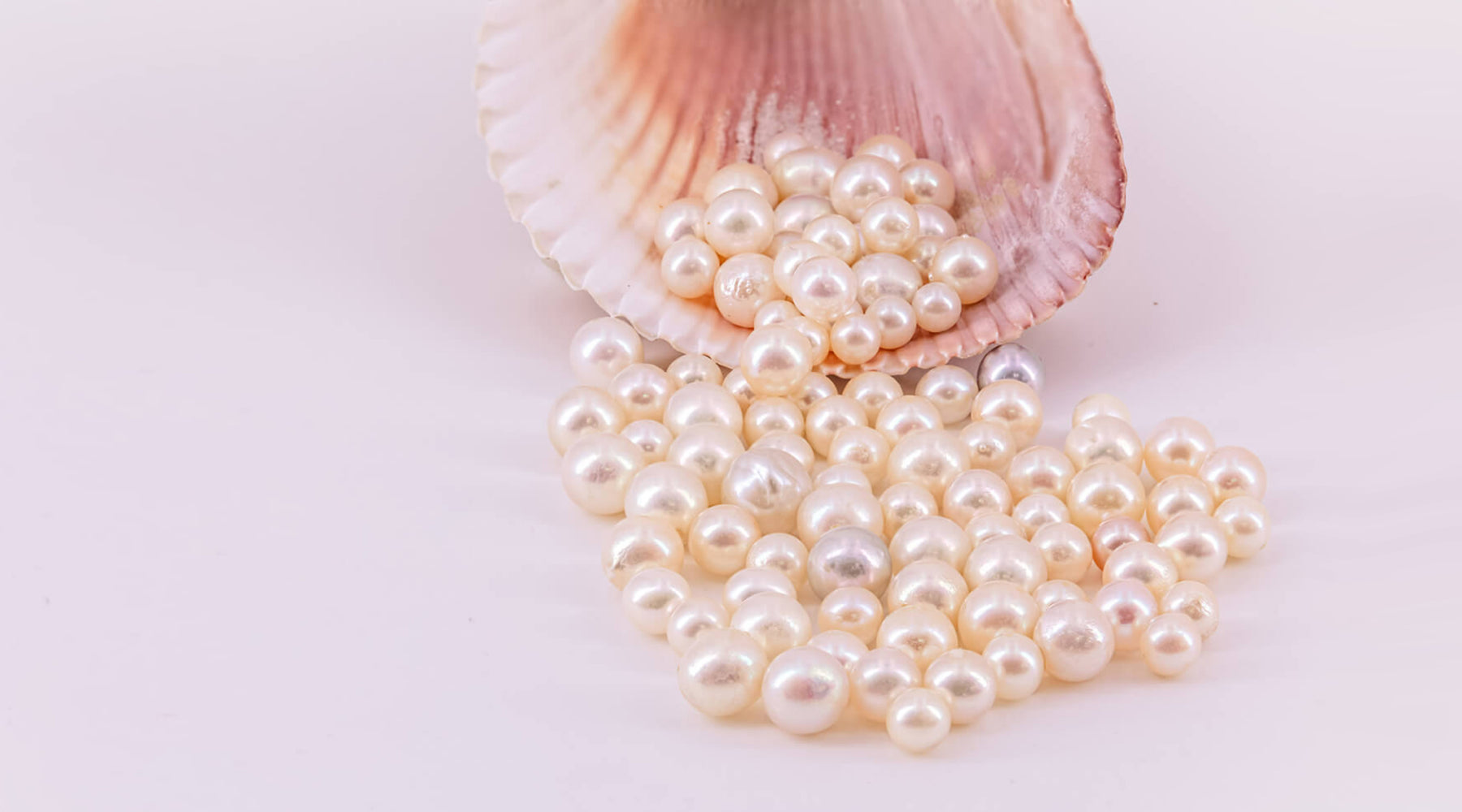Most of us are familiar with the classic white pearls worn by celebrity elites and the socialites of the world. At some point in our lives, we have all thought about owning a pearl necklace or pearl earrings.
And then, one day, you finally decide to buy a pair and find out there are so many types of pearls out there! The wide variety of choices makes customers feel confused and overwhelmed with which type of pearls to buy.
This guide will discuss the two types of white pearls: Akoya Pearls and Freshwater Pearls.
We will highlight the critical differences between both types, including the pros and cons of buying each. So, at the end of this article, you will be one step closer to having your perfect pearls in your jewelry box!
But before we dive into the two pearl types and their characteristics, let’s talk about natural vs. cultured pearls.
Natural vs. Cultured Pearls
One of the most common and confusing questions we receive regarding pearls is: What is the difference between natural and cultured pearls?
Natural pearls are produced by oysters without any human intervention. An irritant gets trapped inside the oyster, and to protect itself from the foreign particle, the oyster will secrete a substance called “nacre.” This layering of the nacre continues and forms a pearl.
Fun Fact: Approximately 1 in 10,000 natural oysters will create a pearl. Of those, a tiny percentage will attain the shape, color, and size desirable in the jewelry industry.
Cultured pearls are made similarly but with a little help from a human. Technicians will implant an irritant into the oysters and return them to their habitat, closely monitoring them as time passes.
And yes, Natural and Cultured pearls are technically 100% genuine pearls.
Now that we’ve established both Akoya and Freshwater pearls are cultured pearls, let’s move on to what Akoya pearls are.
What are Akoya Pearls?
Revered and preferred by jewelers, Akoya Pearls are the most popular choice for necklaces, earrings, etc.
Akoya pearls are popularized due to their perfectly round shape, semi-perfect round shape, and the high quality of their mirror-like luster.
Native to Japan, these pearls come from saltwater oysters called Pinctada fucata. They come in muted colors like white, cream, and grey with silver, pink and green overtones and hues.
These muted colors make Akoya pearls wearable for all occasions, whether in the morning or evening. No matter your pick, you will have a perfect choice that can be worn everywhere!
Their round shape, high luster, and neutral tones make them valuable and, therefore, a worthwhile investment.
What are Freshwater Pearls?
Freshwater Pearls come in various shapes and colors, making them popular with jewelry designers and customers.
They are available an array of soft, pastel colors like peach, pink, lavender, and more, with shapes varying from near-perfect round to oval, drop, and baroque. How cool is that?
They’re primarily found in China and are sometimes referred to as Chinese Freshwater pearls. They come from Hyriopsis cumingi and Hyriopsis schlegeli oysters found in freshwaters, as their name suggests.
Freshwater pearls are more affordable than Akoya pearls, and you’ll see why as you keep reading!
Now, let’s dig deeper into the differences between the two types in their shapes, sizes, colors, and luster.
Key Differences Between Akoya and Freshwater Pearls
1. Pearl Shape
Before we discuss the different shapes of each pearl, let’s talk about the importance of shape when it comes to pearls. The shape of a pearl is a prominent feature that decides its value in the market.
A perfectly round pearl shape is rare. This rarity makes a perfectly round shape pearl high in value. A ‘true-round’ pearl accounts for less than 10% of yearly cultured pearl harvests yield. And extremely rare in a natural oyster.
The more round a pearl is, the higher its price. The value decreases as the shape goes from perfectly round to near round, button, drop, baroque, etc. However, with the advent of manufacturing processes for jewelry pieces, these shapes of pearls are starting to take over the pearl industry for their unique stylings.
Akoya pearls have that desired round shape, making them some of the most sought-after pearls in the world.
These pearls are described as ‘8-way rollers’, meaning that if they roll in every direction smoothly, they’re perfectly round.
It’s good to note that not all Akoya pearls are round. They also exist in free-form baroque shapes, though they’re not as common as round-shaped ones. Baroque pearls make for a talking piece at parties, weddings, and events because every pearl is unique in its shape and size.
Freshwater pearls offer much more variety in terms of pearl shapes. They come in round, off-round, button, and baroque shapes.
If these pearls lack the 8-way roller shape in Akoya, they make up for it by offering tons of unique, whimsical shapes. Smooth-drop Freshwater pearls are tear-shaped pearls and are often considered romantic.
Freshwater pearl jewelry is ideal for daily wear and suitable for every occasion, as it is more affordable than Akoya pearls.
2. Pearl Luster
The next time you come across a pearl necklace, try to recognize the first thing you notice about it. Chances are, your eyes went straight to the glistening pearls themselves. That’s luster!
Arguably, luster is the most crucial characteristic of a pearl. Luster refers to the shine and reflectivity of a pearl surface. Every pearl differs in its luster quality, and pearls high in luster are more valuable in the market.
Akoya Pearls are known for their lustrous surfaces. Often described as mirror-like, one can see themselves reflected on the surfaces of these pearls!
They have a brilliant glow, and light reflects on them brightly and clearly. Their light composition makes them fragile and prone to wear and tear if worn for an extended period.
Freshwater Pearl’s luster is more ‘satiny’ and fuzzy than Akoya pearls. That’s because of their solid crystal nacre, which makes their reflectivity relatively softer. This means freshwater pearls have more of a sheen to them, unlike the brilliant shine of Akoya pearls.
One thing to note about freshwater pearls is their durability. They have a thick layer of nacre, whereas Akoya pearls only have about a 1mm thick nacre layer. This composition for freshwater pearls makes them strong and long-lasting, ideal for you if you wear them daily and for years to come!
Since they rank lower than Akoya in terms of luster, Freshwater pearls are priced lower, which makes them an attractive option for first-time buyers.
3. Pearl Size
Generally, the bigger a pearl is, the more valuable it is. However, that’s not always the case. Akoya and Freshwater pearls are smaller in size than other types of pearls.
Akoya pearls can be as small as 1.0mm and usually go up to 10.0mm, though that is rare. The most common sizes available fall between 6.0mm to 9.0mm.
Their small size makes them perfect for those buying pearl jewelry for the first time and looking for something simple.
Freshwater pearls are slightly bigger than Akoya pearls. The smallest ones are 2.0mm and can be as large as 12.00mm and beyond!
Edison and Souffle Freshwater pearls can go as high as 16.00mm in size. That’s incredible! Freshwater pearls are indeed the king of variety. Edison pearls are large because a bead is inserted inside the oyster, and the nacre forms over the bead. So it is a natural pearl but with a bead center.
The most common size in Freshwater pearl jewelry is around 6.0mm to 9.0mm. To the untrained eye, Akoya and Freshwater jewelry can look the same. If you still can’t tell the difference, look at their colors!
4. Pearl Colors
Another difference between the two types of pearls is their colors.
Akoya pearls are the most neutral due to their muted and limited shade range. They are available in white, cream, and grey colors and subtle pink, silver, and green hues.
Freshwater pearls win in this department as they come in a wide range of pastel colors like pink, lavender, peach, and more. If you purchase freshwater pearls dyed, there are countless color tones. One could say there’s a color in these pearls for everyone!
Conclusion
Akoya Pearls are more expensive than Freshwater pearls due to their perfectly-round shape and high-quality luster. Freshwater pearls often come in other shapes and are not as lustrous as the former pearls.
Freshwater Pearls are more durable and long lasting, making them perfect for extended use. Akoya pearls are less durable in comparison.
Go for Akoya pearls if you want classic white pearl jewelry and have the budget to splurge. On the other hand, if you want variety and are looking for affordability and longevity, Freshwater pearls are perfect for you.
Warning: Some companies will sell you fake Akoya Pearls. Placing freshwater pearls inside Akoya Oyster Shells is common practice in the industry. This is done for many reasons. Akoya Oysters need fewer chemicals to store, and customers like the more durable Akoya Oyster Shell. Hence, make sure you buy your pearls from a reputable company like DezLin.
DezLin.com offers a variety of pearls in a variety of beautiful colors. Check out our collection to find high-quality pearls in your budget!



